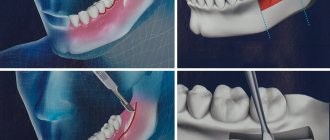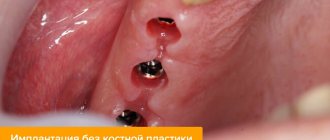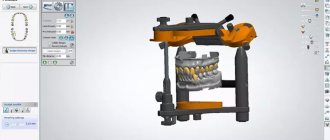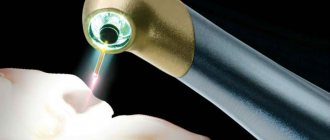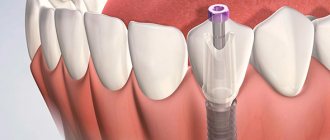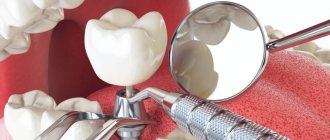The upper jaw is exposed to less chewing load than the lower jaw. Therefore, the bone here is thinner and looser, which complicates the installation of implants. However, if the manipulations are performed correctly, the probability of implantation success is quite high. According to statistics, the average survival rate of implants in the upper jaw is 96-97%. A higher result (99%) is demonstrated by basal implantation with immediate loading, slightly lower results (96-97%) with the classical two-stage technique.
What are the features of upper teeth implantation?
1. After tooth loss, the bone tissue of the upper jaw atrophies (that is, decreases in volume) faster than the lower jaw. Already after 5-6 months, most patients are diagnosed with acute bone deficiency at the sites of defects.
2. Due to the fact that the upper jaw bone is loose, implants “fuse” with it longer. If on the lower jaw the systems take root on average in 2-3 months, then on the upper jaw - in 3-4.
3. Implantation of the upper chewing teeth requires special care, since the maxillary sinuses are located in close proximity to them. Accidental puncture of the sinus threatens the development of infectious complications.
4. When implanting the anterior teeth of the upper jaw, the doctor should pay increased attention to aesthetics. After all, these teeth are responsible for the formation of a smile.
Which crown is better to choose for an implant?
A metal-ceramic crown is an excellent option for chewing teeth. If prosthetics on implants is carried out in the frontal zone of the smile, then it is better to give preference to zirconium crowns and, accordingly, zirconium abutments. Zirconium dioxide crowns are translucent and look natural. In the case of metal-ceramics, it is possible for metal to penetrate through the gum.
Expert opinion
Vladimir Aleksandrovich Voznyuk
maxillofacial surgeon, implantologist
Experience: more than 33 years
In whatever area of the upper jaw a “gap” is formed - frontal, lateral or chewing - a negative impact on the body is inevitable. The fact that the absence of a tooth is not noticeable from the outside is not an argument in favor of refusing restoration. Decreased quality of chewing function, malocclusion, increased load on neighboring teeth, and as a result - their rapid destruction - these are just some of the problems that will become obvious in the near future. Implantation of teeth in the upper jaw will stop bone atrophy, ensure normal chewing and consumption of any usual food, and prevent early aging of the face. When planning implantation, it is important to choose a reliable clinic and specialist who will individualize the approach to the problem and propose a protocol that is optimal for you.
Four, six... or maybe three?
Nobel Biocare is rightfully considered a leader in the field of implantological innovations, although some of the solutions they offer are, to put it mildly, widely discussed in the professional community. So, most recently, she proposed the Trefoil concept, which allows the use of only three (!) implants to support a fixed prosthesis:
It is also worth noting that the All-On-4 scheme, i.e. “all-on-four” was also proposed by specialists from Nobel Biocare, and the rest, it seems, turn out to be “repetitive pigs”:
Of course, this does not mean that this concept cannot be implemented with other implants - of course it can, and we do it all the time:
The point is different:
Trefoil, like All-On-4, were developed and offered by Nobel with a lot of reservations regarding indications and contraindications; they are compromise schemes and, therefore, cannot be applied to all clinical cases.
The relative cheapness and apparent simplicity have led to the fact that some doctors have significantly expanded the indications for prosthetics using these methods - as a result, now we see not just a large, but a gigantic number of problems in the near and distant future. In fact, now we are seeing the same picture as with basal implantation, when a specific and extremely compromise method was turned into almost a panacea, “used” in absolutely all clinical cases. With predictable consequences, of course.
To prevent this from happening with four implants installed to support a fixed prosthesis, you should know that:
– the cheapness of such a design is a myth. The angled multifunctional abutments used in it are sometimes more expensive than two additional implants.
– for All-On-4 and especially for Trefoil, only original components of implantation systems can be used. Which is also reflected in the price, which is not at all positive. The use of counterfeit, counterfeit and incorrect spare parts is one of the main causes of complications, and very serious ones, such as fractures and loss of implants.
– the main reason why implants are placed at an angle is the desire to avoid expensive osteoplasty or sinus lifting in the lateral areas. You have to pay for this with an uneven and very compromise distribution of the load, in the vector decomposition of which a nonspecific component appears that sets the torque. Simply put, when the implant is placed in this way, the load on it is transferred and distributed in a way that is not at all how it should be distributed.
That is why such prosthetic schemes are recommended for patients with long-term absence of teeth and significant, at least 10-15 years, experience in using complete removable dentures. If we implement the “all-on-four” technique for prosthetics for a healthy man who lost all his teeth two months ago due to periodontitis, then with a high degree of probability we will end up with a lot of problems.
This technique cannot compensate for significant bone atrophy. Why? Because in this case, the massive base of a fixed prosthesis will create hygiene difficulties. In this case, it would be more correct to consider a removable denture supported by a beam fixed on implants, which we talked about a little earlier.
– immediate loading, such as “teeth in one day”, when implementing the “all-on-four” method is rare. It is not always possible to do this; this is rather the exception than the rule. All dentists are happy when this happens; they immediately run to post these works on their pages on social networks.
Why? Because of course it is possible to make a denture supported by installed implants, but to make a correct and functional denture is, unfortunately, almost impossible. Therefore, if you have the opportunity to avoid immediate prosthetics on implants, it is better to do so. If you hurry, you will make people laugh.
Therefore, we try not to load the implants immediately after installation, using the remaining teeth as support for the prosthesis:
If there are opportunities (namely, the remains of natural teeth), we use this approach quite often. Yes, it turns out to be more expensive than “all at once,” but it carries much fewer risks than immediate prosthetics itself. In particular, this applies to the “all-on-four” scheme.
And yet, when is “all-on-four” a good, usable technique? Frankly, we do not consider it a good and suitable technique even for the small number of clinical cases for which it is intended.
Those whales on which its popularity, speed, cheapness, simplicity rest, turn out to be not whales at all, but, at most, minnows.
Therefore, the only fixed structure that has the qualities we need is a bridge supported by six or more implants:
This technique can be considered a proven classic, because it is manufactured according to the same principles as implant-supported bridges.
The only difference is that often, very often, imitation gums are used to compensate for bone tissue atrophy (and increase interalveolar height):
Rarely, very rarely, usually with immediate implantation, we can do without artificial gum:
We classify such clinical situations as “LUCKY!”, because most often, in order to create teeth of the desired shape and height, the prosthesis needs some kind of base to compensate for the loss of bone.
Again, the type of prosthetics, removable or fixed, will depend on its thickness. If there is significant loss of bone tissue and the need for a thick base, it is better to consider the option of a removable denture supported by a bar. Then it will be much easier for the patient to care for it, therefore, we will not worsen the quality of life and will not reduce the service life of the structure itself.
The same goes for more implants - seven, eight, ten, twelve... Increasing the number does not improve aesthetics, will not get rid of artificial gums and will not improve your life if bone atrophy has gone too far. A simple example is basal implants, which are installed in dozens, but patients still remain dissatisfied.
And the quality of implantation and, especially, prosthetics means, first of all, a satisfied patient.
Unexpectedly for ourselves, we realized that it is impossible to talk about all the nuances of prosthetics in two or three articles. Having simplified some concepts, removed terms, made huge assumptions and adapted the text for ordinary people, we have not been able to present even half of what we consider necessary. No matter how much information there is about prosthetics, it will always be not enough. And there is an explanation for this.
With implants, everything is very simple - in fact, we have several dozen implantation systems and several hundred standard sizes. Whatever the implant, neither its brand, nor its shape, and especially the country of origin, determine the quality of the treatment performed.
At the same time, a denture, an aesthetic and functional imitation of a natural tooth, is individual and unique. Just as there are no two absolutely identical teeth in the world, there will never be two identical dentures. Dental prosthetics is always handmade, delicate and delicate, taking into account a thousand nuances and little details.
No matter what they say, no matter what marketers write about, a scanner-computer-milling machine will never replace a qualified dental technician and prosthetist. Not a single, even the most advanced computer program that operates with standard libraries of tooth shapes and sizes will reduce the relevance of the experience, competence, vision and simply aesthetic taste of the right doctor.
Suddenly a terrible event happened - a man lost all his teeth. If earlier it automatically transferred an active and young person to the category of an old man, now we have learned to restore entire rows of teeth with a high degree of reliability and an increase in the quality of life. For this purpose, we use dental implants as supports for dentures.
No matter what the advertising tells you, dental prosthetics is a long, complex and, unfortunately, very expensive treatment process.
The type of prosthetics (removable or fixed), as well as the number of implants (four, six or more) are selected based on the clinical picture and take into account a huge number of factors. Of course, we take into account all the “patients’ wishes,” but only if they do not contradict common sense and do not negatively affect the quality of prosthetics.
Therefore, when we talk about planning such treatment, its timing and, especially, cost, we need to act wisely and consider each case individually. The best option is an in-person consultation with a specialist doctor. All you need to do is call us, write to any of the instant messengers, leave a message on our social network page or simply fill out a form on the website, and then choose a convenient time to meet with the doctor.
Thank you for reading to the end.
As always, we are ready to answer all your questions in the comments under this article.
Best regards, CLINIC IN
What else can you read about dental prosthetics at CLINIC IN?
A whole section about dental prosthetics
You are planning dental prosthetics. What do you need to know about this before consulting a dentist?
Implant-supported prosthetics – how is it done?
A whole section on dental implants
Orthopedic implant platform – cones, hexagons and screws
About the quality of implantation
Implantation options for small defects in the upper dentition
In the absence of 1-3 consecutive teeth, patients are recommended to receive classical implantation. This is the only technique that allows you to work in a limited volume of bone.
The procedure is carried out in two stages:
- At the first stage, the doctor peels off the gum flap and forms a bed in the bone with a special tool, in which he places the root part of the implant. The gum is sutured. Next, the doctor and patient wait 3-4 months for the structure to take root—during this time, bone cells penetrate the pores of the implant and literally fuse with it.
- In the second stage, the gums are reopened. A gum former is installed on the artificial root, which helps create a beautiful contour of the soft tissue around the neck of the implant. After 2 weeks, the former is replaced with a supragingival head (abutment), on which the crown is fixed.
In total, classical dental implantation in the upper jaw takes about six months.
Important note: if the results of the examination reveal that the patient has bone atrophy, he undergoes an additional procedure before implantation - bone grafting. As a rule, after such an operation, another 3-6 months must pass before the bone volume is restored and becomes suitable for the installation of implants.
Delayed prosthetics on implants.
From the point of view of predicting the success of implantation, this technique is considered the safest. Especially if a two-stage implantation is carried out: during the healing period of the implant, it is tightly sutured under the gum for a healing period of 3 to 6 months. In this case, the entry of microbes and bacteria into the implanted area is excluded and the implant fuses with the bone without the risk of harmful microorganisms. Even accidental chewing movements on the healing implant are also excluded. The disadvantage here is the lack of aesthetics during the period of osseointegration and repeated surgical intervention after a certain time. When you need to open access to the implant and install a gum former on it.
With one-stage dental implantation, the former is installed immediately. The advantages are the absence of additional surgical intervention after implant integration and time savings of 3 weeks (the period of stay with the gum former).
Implantation options for medium and large defects
If there are a large number of missing teeth, classical implantation becomes impractical. Firstly, due to the high level of trauma, the risks of intervention increase many times over. Secondly, such treatment is expensive for patients. Therefore, patients are recommended methods of one-stage implantation of the upper jaw, which reduce the number of surgical procedures and avoid the procedure of bone augmentation:
- Basal implantation .
It is used in the absence of 3 or more missing teeth in a row (including a completely toothless jaw). The essence of the method is that implants are installed in the deepest and densest layers of the jaw, which do not thin out over time. As a result, the systems are firmly and securely attached to the bone. During basal implantation of the upper teeth, the gums are minimally injured, since the implants are screwed in without incisions, through small punctures. Already 3 days after the operation, a fixed prosthesis is fixed on the implants. Along the edge of the prosthesis there is an acrylic gum, which hides the imperfections of the patient’s own mucosa and provides a good aesthetic result. Due to its lightness, the design does not interfere with the normal healing of implants. Almost immediately after prosthetics, the patient can chew food fully. - Methods ALL ON 4 or ALL ON 6.
Indicated for moderate bone atrophy in the patient and complete absence of teeth. Only 4 or 6 implants are installed in a toothless jaw. Of these, two are vertical, in place of the front teeth, the rest are in the lateral areas of the jaw. This approach allows you to bypass the most atrophied areas and fix the implants where more bone is preserved. Prosthetics are performed on the same day or 2-3 days after surgery. Patients are fitted with the same fixed prosthesis as with the basal implantation method.
The doctor selects a suitable implantation technique in the absence of upper teeth based on the results of an examination and computed tomography.
Complications and side effects
Implantation is a surgical procedure and carries a risk of complications. Side effects can occur within a few days or weeks, or after 2-3 years.
The following factors can provoke the development of complications:
- Chronic diseases.
- Insufficient examination, inaccurate history taking and incorrect diagnosis, which led to the failure to identify existing contraindications.
- Mistakes made by the implantologist during surgery.
- Neglect of the patient's advice on care.
Immediately after implantation or within a short time, the following complications may begin:
- Painful sensations . Occurs after the anesthesia wears off. A normal reaction is the persistence of painful sensations for no more than three days, during which analgesics can be taken. Prolonged pain may indicate inflammation or nerve damage.
- Swelling. A normal reaction to a violation of the integrity of oral tissues. It appears a few hours after surgery and disappears after 5-7 days. If it persists for more than a week, it may be a symptom of soft tissue inflammation. To reduce swelling, it is recommended to apply cold to the injury site.
- Some bleeding in the first few days is normal. May be caused by taking medications that reduce blood clotting. Severe bleeding or minor bleeding that does not stop for 10 days is a sign of damage to the blood vessels, which is dangerous due to the formation of a hematoma, suture dehiscence, or suppuration.
- Temperature increase . An increase in temperature to 37-38°, observed within three days, is considered normal. Prolonged fever is a sign of an inflammatory process.
- Seams coming apart . Happens due to:
- mechanical damage;
- improper suturing;
- inflammation.
A few months after surgery, the following may occur:
- Peri-implantitis is an inflammation of the jaw bone around a dental structure. Peri-implantitis develops for the following reasons:
- trauma to the wall of the nasal cavity;
- development of bleeding over the plug, causing hematoma and suppuration;
- making a mistake when closing a postoperative wound;
- incorrect technique for forming a bed for the implant;
- inflammation that has developed in a neighboring tooth;
- allowing for inaccuracies in the manufacture of the prosthesis;
- failure to comply with hygiene rules by the patient.
- peri-implantitis;
- insufficient bone volume;
- excessive bone damage during implantation;
- exacerbation of chronic diseases;
- allergy to the rod material;
- smoking;
- temperature damage to jaw tissue;
- osteoporosis of the jaw.
Stages of implant installation
- Preparing for treatment .
On the first visit, the doctor examines the oral cavity and talks with the patient. Possible treatment options are discussed. If there are no obvious contraindications to implantation, the patient is sent for a computed tomography (CT) scan and sometimes additionally for a blood test. - Treatment planning.
CT data is loaded into a special program that recreates a three-dimensional model of the patient's jaw. Based on this information, suitable implant models are selected and their installation locations are determined. A surgical template is then created in the laboratory using the 3D model to be used for the operation. - Implantation of upper teeth.
Under local anesthesia, through incisions (with the classical method and ALL ON 4/6 methods) or through small punctures (with the basal method), the implants are implanted into the jaw. - Prosthetics .
Depending on the protocol used, the dentures are fixed on the implants for 2-3 days or several months later.
Success of prosthetics on implants.
It is determined by several components:
- It is important not only the correct installation of the implant, but also the high-quality production of the prosthesis for it. The qualification level of two specialists is important: an implantologist and an orthopedist.
- Selection of proven, certified implantation systems.
- The use of high-quality materials not only for the manufacture of prostheses, but also consumables, for example, such as impression mass. The final accuracy of the fit of the prosthesis will depend on the quality of the impression taken.
- Compliance with all recommendations of the attending physicians during the period of dental restoration using this method of prosthetics.
The structure of prosthetics on implants has two components: what is located under the gum (the artificial root itself - the implant) and above the gum - this is the abutment and the crown (prosthesis).
Cost of implantation of upper teeth in Moscow
The cost of implantation depends on the clinic, the type of implants and the patient’s situation. On average, the price for installing one implant varies from 30,000 to 60,000 rubles. Complete jaw implantation will cost 200,000 - 400,000 rubles.
ROOTT centers support an affordable pricing policy. The cost of installing one classic implant (two-stage protocol) in our clinics is 32,000 rubles. The production of a crown is paid separately (from 28 thousand rubles).
Implantation of more than 3 upper teeth using the basal protocol will cost an average of 80,000 -110,000 rubles. And the price for a complete restoration of the dentition will be 265,000 rubles - this price already includes the required number of implants, X-ray diagnostics, doctor’s work and a fixed prosthesis.
Cost of prosthetics on implants
| Name of service | price, rub. |
| Making a temporary crown supported by an implant | from 5900 |
| Metal-ceramic crown (KHS) supported by an implant | from 27700 |
| Ceramic crown on a zirconium oxide frame supported by an implant | from 45900 |
| Custom titanium abutment | from 17300 |
| Custom Zirconium Oxide Abutment | from 28080 |
| Conditionally removable prosthesis supported by implants | from 62000 |
| Diagnostics | price, rub. |
| Orthopantomogram (as a separate procedure) | 1320 |
| Computer tomogram (fragment of the dentition up to 3 teeth) | 1980 |
| Computed tomogram (1 jaw) | 2730 |
| Computed tomogram (2 jaws) | 4400 |
| Additional manipulations during dental prosthetics | price, rub. |
| Infiltration anesthesia | 640 |
| Taking an impression | from 800 |
Ilgam Vagifovich Mamedov
Dentist, orthopedist
28
years of experience
Doctor of the highest category
All types of orthopedic treatment
Sign up for a consultation
Where to go for upper jaw implantation in Moscow
The main feature of dental implantation in the upper jaw is its structure. The bone here is more porous and susceptible to the rapid development of atrophic processes after tooth extraction. The algorithm for installing implants in the maxillary bone often requires a preliminary sinus lift.
After administering local anesthesia, the surgeon makes an incision in the gum, exposes the bone and prepares the implant bed. At this stage, the implantologist must have great intuition and experience. The next step, that is, installation of the implant, determines the success of the procedure. Finally, the implant is closed with a closure or healing screw, or a temporary prosthesis is placed on it. If the procedure was performed under local anesthesia, the patient can go home after a short time. If the anesthesiologist has performed sedation, he decides how long the patient will be monitored in the clinic. Usually this is no more than half an hour.
The choice of dentistry for dental implantation of the upper jaw is extremely important, because the final result depends on the experience of specialists and the level of equipment of the clinic. The approximate cost of this dental service in Moscow clinics is given in the table below.
| Name | Clinic address | Service cost |
| ROOTT |
|
|
| Shandora | Moscow, Kolpachny lane, 6, building 4. |
|
| Dentistry Grand Smile | Moscow, st. Miklouho-Maklaya 43 (metro station Belyaevo, Yugo-Zapadnaya, Kaluzhskaya) | Prices for dental implantation from 30,000 rubles (MIS system) to 70,000 rubles (Nobel) |
| Dentistry City Dent | Moscow, st. Novocheremushkinskaya, 57 | Implantation of one tooth with the Astra Tech system – 52,000 rubles |
| Dentistry Vita-Stom |
| Implantation of one tooth with the Straumann system (Switzerland) – from 32,000 rubles. |
The first two weeks after surgery, during which tissue healing occurs, are key to the success of the overall treatment, regardless of whether you had your front teeth restored or your posterior upper teeth implanted. At this time, it is very important to follow the doctor’s recommendations:
- For 7-10 days, the implant area must be washed with saline solution after each meal to maintain proper cleanliness.
- If during the first 2 weeks the patient experiences discomfort when using dentures (excessive pressure), it is necessary to contact the dentist to adapt the dentures to the anatomical conditions of the oral cavity.
- After the procedure, it is recommended to eat only liquid and semi-liquid foods.
- Bruises and hematomas are not a cause for concern; they are a common complication that does not require additional treatment.
Other jobs
How long does it take for the structure to take root on the lower jaw?
The speed of engraftment is affected by:
- State of health and age of the patient . The younger the person, the faster the healing process will take place. Chronic diseases can slow down engraftment.
- Preparing for surgery . A thorough history and examination of the oral cavity is important. The engraftment process is also influenced by the experience and qualifications of the doctor. Before the operation, the specialist must carry out the necessary hygiene procedures and research to obtain information about the state of health and identify contraindications.
- Correct selection of implant model . A rod that is too short and thick simply will not fit into the jawbone. Excessively long can injure tissue. The quality of the material also influences the engraftment process.
- Actions of the implantologist . If no rejection occurs during the first days, and no complications arise during implantation, we can talk about the success of the operation.
- On which jaw was the implantation performed ? It takes root faster on the lower jaw, since its structure is more dense. The bone of the upper row has a loose structure due to the large number of airways it contains.
- Compliance with the dentist's recommendations. In the postoperative period, it is important to maintain oral hygiene, take prescribed medications and visit the dentist in a timely manner.
In the first weeks after surgery, damaged bone tissue is restored, and trabecular bone is formed around the rod. This type of bone is fragile and cannot withstand chewing loads. It takes at least 18 weeks for the formation of a strong structure, called lamellar. This bone fills the gaps between the dental structure and jaw tissue, and is able to withstand the chewing process.
On average, an implant takes 4 months to take root in the lower jaw, and six months in the upper jaw.
Examples of work “Before” and “After”
Restoration of all teeth on the upper and lower jaw - basal implantation
Case: partial absence of teeth on the upper and lower jaw, complicated by severe periodontitis (tooth mobility).
Restoration of the upper jaw - basal implantation (March 2012)
Case: partial absence of teeth in the upper jaw, the remaining teeth are mobile and cannot be restored.
Restoration of the upper jaw - basal implantation
Case: the patient came to the Simpladent clinic with complaints of a fracture of teeth under a metal-ceramic structure and mobility of the latter in the upper jaw.
Basal implantation in case of complete absence of teeth in the upper jaw
Case: partial absence of teeth in the upper jaw, the patient also complained of mobility of the bridge, the remaining supporting teeth were destroyed.
Reasons for missing teeth
1-2% of the population has a genetic disorder in which teeth are initially absent or their number is abnormally small. In the vast majority of cases, the absence of lower or upper teeth is a consequence of illness or mechanical damage. Doctors at the clinic name the main reasons:
- Untreated caries or pulpitis. Tooth tissues are destroyed, in advanced cases, inflammatory processes in the gums begin, and the bone structure changes. Our dentists try to preserve every unit. But, if the process is already irreversible, then it is necessary to remove one tooth or several.
- Inflammatory processes in periodontal tissues lead to the fact that the ligament cannot hold the tooth in the socket. The crown becomes loose, destructive phenomena progress, and the gums and bone are destroyed.
- Injuries. The complete absence of teeth or partial adentia is caused by dislocations, bruises, fractures of the tooth crown or root, and other damage resulting from mechanical impact.
Sometimes teeth can be lost after suffering from somatic diseases: oncological, endocrine, and others that weaken the immune system and affect the structure of tissues.
Advantages and disadvantages
Conditionally removable prosthetics on implants is a technique that allows you to obtain the following advantages when restoring lost teeth:
Comfort during use. Adaptation to the prosthesis is quick and is not accompanied by diction problems; the prosthesis does not fall out of the mouth when talking or eating;
All fastening elements are located inside the prosthetic product and are therefore completely invisible in the oral cavity;
The conditionally removable prosthesis itself has compact dimensions;
Injury to the soft tissues of the mouth is excluded;
Correction of prostheses is necessary only during the period of osseointegration of implants;
Long useful life of prostheses. Conditionally removable products last twice as long as removable structures, as they are more resistant to external factors and mechanical load;
Conditionally removable structures do not require complex and specific maintenance. They do not have to be regularly removed from the mouth and stored in a special container. From time to time you will visit the dentist, where your dentures will be professionally cleaned.
The only disadvantage of conditionally removable prosthetics is the higher cost, as well as the presence of a plastic base in the design. A base made of polymer material can cause an allergic reaction, but modern conditionally removable dentures on implants use hypoallergenic materials that do not cause irritation to sensitive mucous membranes.
How to speed up the healing time of implants
Osseointegration is a physiological process, the speed depends on the condition of the patient’s bone tissue, the implantation method, and compliance with recommendations. But to protect yourself from unwanted rejection, you need to take care of this in advance:
- choose a clinic carefully - you should contact trusted institutions based on recommendations from friends after carefully studying the site and available information;
- contact a qualified doctor - you cannot go to a private specialist who does not officially work in the clinic, you should ask him for certificates, look at photos of examples of work;
- do not refuse preliminary preparation and diagnosis - a qualified doctor will insist on this stage;
- choose high-quality implants - preference for companies that have been presenting products on the market for at least 10 years;
- find out the warranty period and service - the nuances should be clarified before the procedure;
- check compliance with sterility and safety - clinics with a good reputation should work according to the Anti-AIDS-Anti-Hepatitis program.
Top brands
Global implant manufacturers often produce brand lines with different diameters and lengths. This allows you to choose the most suitable option for a particular patient, taking into account the structural features and condition of the maxillary tissues. Popular brands:
- Nobel Active (Nobel company, USA) - high-quality titanium roots with a minimum diameter and long enough to reach the basal layer of the jaw tissue; have a special coating that speeds up the implantation process; installed on the front teeth, provided there is a sufficient amount of gum tissue;
- PURE (Straumann company, Switzerland) – zirconium implants, beautiful and durable, coated with a composition that makes the roots take root better; suitable for any units of the dentition;
- Bone Level Tapered Small One (Strauman) – implants made of ultra-strong material Roxolid with a minimum diameter; ideal for the smile area of the upper jaw, even with slight atrophy of bone tissue;
- Bone Level Tapered (Straumann) – also Roxolid material, diameter and length are different; in the smile area, implants with a small diameter and sufficient length are used to penetrate the basal layer, on chewing units - standard ones; a feature of this design is its manufacturing technology, as a result of which artificial roots take root better;
- Hi-Tec (Hi-Tech company, Israel) – high-quality titanium implants with different diameters; this allows you to select a model for any tooth in the dentition of the upper jaw; The quality is practically not inferior to the Nobel brand, but their price is much lower.
Implants from popular brands
The dentist and the patient decide which brands are best suited in a particular case. The effectiveness of implantation depends not only on the quality and price of the brand, but also on the skill of the implantologist. Even inexpensive models installed by a qualified specialist will take root well in the tissues of the jaw, will last and will be a reliable support for the prosthesis.
Digital diagnostics - to eliminate risks
A Sirona Galileos computed tomograph (Germany) with ENT mode settings is used
- Assessment of bone parameters in the implantation zone, location of the maxillary sinuses
- Analysis of the condition and position of tooth roots during single-stage implantation
- 3D operation planning, creation of navigation templates
Implantation methods
To restore the upper teeth, we use all known techniques that are suitable for various clinical situations.
- Classic two-stage Includes two stages - implant installation and crown prosthetics. Up to 6 months pass between them, during which time the implant reliably fuses with the jaw bone without load.
- One-stage with immediate loading A temporary crown made of medical plastic is placed immediately after surgery - a new tooth in 1 day. After engraftment, the implant is replaced with a permanent one made of zirconium dioxide.
- Instantaneous after tooth extraction The implant is installed in the socket of the removed root. Treatment time is reduced by 5 months—there is no need to wait for bone restoration after removal.
- Mini-implantation Small implants are used, which are placed even in atrophied bone and take root quickly. Suitable for complete edentia as a temporary solution.
The upper dentition forms a smile to a greater extent than the lower one. Therefore, implantation places high demands on both functionality and aesthetics. If the technique does not involve installing a crown on the implant immediately, a temporary removable orthopedic structure is used during its healing. In any case, you will not leave our Center without teeth.
We work exclusively with premium Nobel Biocare® implants. We use only original prosthetics, which guarantees a long service life of crowns and dentures. We provide an indefinite guarantee for implantation in the LifeTime Warranty format. Since 2004 we have been the Nobel Biocare® Center of Clinical Excellence in Eastern Europe.
What to do if there is not enough bone tissue to implant implants on top
In case of unsatisfactory condition of the bone structures of the upper jaw, a sinus lift procedure (building up the bone to the required volume) is performed before implantation. The essence of the technique lies in raising the bottom of the maxillary sinus and filling the resulting space with biomaterial. The operation can be performed in two ways:
- open;
- closed.
Open includes several stages:
- Gum section.
- Cutting the outer layer of bone using a ball-shaped bur.
- Providing access to the maxillary cavity.
- Gently lifting the bottom of the maxillary sinus.
- Placement of bone material into the resulting space.
- Installation of a protective membrane.
- Stitching.
It takes 5-6 months for the graft to engraft. When the planted biomaterial grows with blood vessels and becomes viable, an implant is implanted into it.
The closed sinus lift technique is indicated for alveolar ridge heights of 7-8 mm. All procedures are performed through a puncture, not a cut. Bone granules are inserted through a miniature hole. The implant is placed immediately after the procedure is completed.
PiezoSurgery® - gentle tooth extraction and sinus lift
For pre-implantation preparation, the NSK VarioSurg 3 ultrasonic scalpel is used
- Affects only hard tissues, damage to nerves, blood vessels or sinus lining is excluded
- Does not damage the bone around the teeth during extraction
- Gently works with bone tissue during osteoplasty

